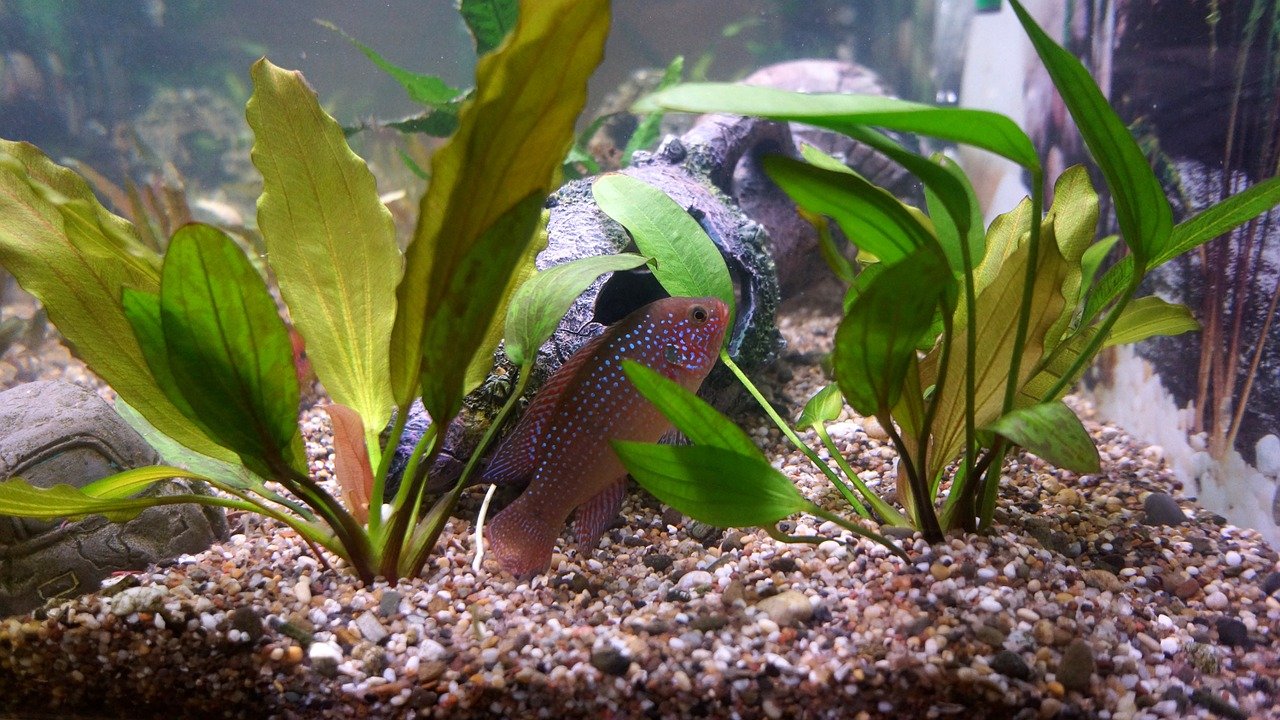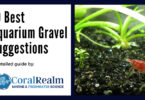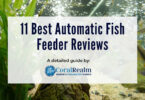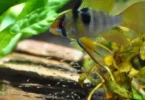Last Updated on February 10, 2023 by Matt
Properly cycling a fish tank is a very important step in setting up a new tank. If you simply put water into your new tank, add decorations and plants, set up your filtration system and then put your fish in, they will most likely die.
In nature water isn’t pristine and clean. It is a mixture of nutrients, soil, fish, plants, and everything else you can think of. Fish, plants, and bacteria live in harmony in nature, and you need them to do the same in your aquarium.
Cycling your aquarium basically does this. Cycling the fish tank is the process of enabling bacteria to colonize the aquarium and filter so that they can process dangerous compounds such as ammonia and nitrite which will otherwise kill your fish.
In this article we will explain exactly how to cycle a fish tank. First off we will explain the importance of the nitrogen cycle in your aquarium, what happens if you don’t cycle a tank, then end on three different ways you can cycle a fish tank.
IN THIS ARTICLE
The Importance of the Nitrogen Cycle

The aquarium nitrogen cycle is vital to the health of your fish and the overall health of your tank.
This cycle describes the movement of nitrogen through the ecosystem, in this case your aquarium. Cycling a fish tank is essentially setting the nitrogen cycle in motion so that the action of bacteria will remove dangerous nitrogenous compounds from the water column.
It is important to understand the aquarium nitrogen cycle in order to understand how important cycling a new fish tank is.
As organic matter such as fish feces and excess fish food decompose, the bacteria which break down this organic material release ammonia. In a process called nitrification, other bacteria convert ammonia to nitrite. Other species of nitrifying bacteria then convert nitrite to nitrate. Then in a process called denitrification bacteria convert nitrate to atmospheric nitrogen.
Nitrification occurs mainly in the biological filtration system in your aquarium filter. However this bacteria will also grow in the mechanical filtration media and in the substrate. Denitrification is a little different as it is an anaerobic process. For this process to take place the bacteria need to be able to have a place without oxygen to colonize. There are specific biological filter media that are very porous which will provide this.
So basically, ammonia is produced when waste breaks down, and bacteria convert this through nitrite to much less harmful nitrate. However in new tanks this bacteria doesn’t exist in the system yet. So this process cannot happen. Ammonia will build up and poison and then kill your fish unless you take steps to cycle the tank and enable this bacteria to colonize the tank.
What Happens If You Don’t Cycle a Tank
If you don’t cycle a fish tank you will find your aquarium suffering from new tank syndrome. In new tank syndrome ammonia levels will spike and rise to dangerous levels, as will nitrite concentrations. This will result in ammonia poisoning and nitrite shock.
Ammonia and nitrite are very toxic to fish, even in small concentrations. New tank syndrome can easily kill your fish, and at best if you catch it early your fish will become very unhealthy.
This is caused by the nitrifying bacteria that convert toxic ammonia and nitrite to nitrate not being present in the fish tank system.
What Happens to the Water Chemistry During the Cycling Process?
You might be a little confused as to exactly what is happening with ammonia, nitrite, and nitrate levels in the tank during the fish tank cycling process.
First of all, ammonia levels will rise and spike, as there aren’t the nitrifying bacteria present yet. As these bacteria grow in number, the ammonia will be converted to nitrite. As such, ammonia levels will decrease to 0 parts per million (ppm), and nitrite levels will spike. Then as the nitrite converting bacteria grow in number, the nitrite levels will decrease to 0 and nitrate levels will rise. As denitrifying bacteria grow, nitrate levels will lower slightly, but nitrate will still be present.
In a completely cycled tank, ammonia and nitrite levels will be at 0 ppm, and nitrate levels will be below 50 ppm, and ideally around 25 ppm. It is recommended to test the water column regularly for these nitrogenous compounds using a good aquarium test kit.
The API Aquarium Test Kit contains ammonia, nitrite, and nitrate testing kits so that you can keep an eye on how the cycling process is progressing.
- Contains one (1) API FRESHWATER MASTER TEST KIT 800-Test Freshwater Aquarium Water Master Test Kit, including 7 bottles of testing solutions, 1 color card and 4 tubes with cap
- Helps monitor water quality and prevent invisible water problems that can be harmful to fish and cause fish loss
- Accurately monitors 5 most vital water parameters levels in freshwater aquariums: pH, high range pH, ammonia, nitrite, nitrate
- Designed for use in freshwater aquariums only
- Use for weekly monitoring and when water or fish problems appear
How to Cycle a Fish Tank

So now you know that cycling an aquarium is just getting the bacteria of the nitrogen cycle present in your tank, we will now explain how to cycle a fish tank.
There are a few different ways that you can successfully cycle a fish tank. Fish in cycling is the process of cycling an aquarium with fish present in the tank. Fishless cycling is the process of cycling the tank with nothing in there, and plant cycling is where the tank is cycled with plants present. Fishless cycling and plant cycling are much safer options, but are a little bit trickier than fish in cycling.
We will run through how to cycle your aquarium using each of these methods. With all these methods, you want to have the fish tank completely set up. You need to have the filtration system, aquarium heater, thermometer, wave maker, air stones, and any decorations you want in the tank all present and working.
Cycling a fish tank can take up to a couple of months, and whichever of these options you choose to take you should test your water chemistry often for ammonia, nitrite, and nitrate.
Fish In Cycling
Fish in cycling is a common way for beginner aquarists to cycle their aquariums. In this method, fish are present during the cycling process. In this process, as the fish release ammonia into the water column through their gills, and decomposing waste releases ammonia, the ammonia concentration rises. Nitrifying bacteria then use this ammonia to grow in number and colonize your tank.
They then convert the ammonia to nitrite, and the ammonia concentration decreases as the nitrite levels increase. The same process happens as the nitrite allows for the bacteria to grow and convert this to nitrate.
As the fish are going to be exposed to high ammonia and nitrite levels, you want to only set up your new tank with the hardiest fish you plan on keeping first. You also don’t want to overstock your fish early on. Only keep one fish per 10 gallons of water in your tank; any more and you risk the ammonia levels getting too high even for the hardiest of fish.
Only feed your fish the bare minimum at first, and gradually build up to where you are feeding what your fish can finish in 2-4 minutes. If you overfeed early, you fuel ammonia production with no way of converting it to less toxic compounds.
You can speed up the cycling process greatly by using aquarium bacteria supplements. We will run through the process of using bacteria supplements later in the article.
Fishless Cycling
Fishless cycling is the name given to the method of cycling a new aquarium with no fish present. This method gives an obvious advantage over fish in cycling in that no fish are present in the tank for the ammonia and nitrite spikes which are dangerous for their health.
However what can be more tricky is that for the bacteria of the nitrogen cycle to colonize your filter, they need a source of food, or ammonia. In fish in cycling, this source comes from the fish themselves; they release ammonia through their gills and as their waste decomposes. Without fish, there is no ammonia, and so no food source for the nitrifying bacteria. Therefore you need to provide the source of ammonia yourself. DrTim’s Aquatics provides an ammonium chloride product which you use to provide the source of ammonia for nitrifying bacteria.
What is also imperative in fishless cycling is that you introduce nitrifying bacteria into the fish tank using aquarium bacteria supplements. In fishless cycling there are no external sources of ammonia or bacteria, so you need to add in bacteria and a source of ammonia so that they can colonize your filter and tank. Otherwise you are in for a long ride!
Plant Cycling
Plant cycling is the process of cycling a fish tank with no fish present, but instead focusing on getting a healthy planted tank ready before adding fish. It is essentially a better version of fishless cycling, and in our opinion this is the best option of the three.
You should get your tank completely ready just with no fish. You want to have the internal design down; add substrate, live plants, and any decorations you want. Then you want all the essential add-ons; an aquarium heater, filter, thermometer etc. You can then focus on keeping the plants healthy as your tank cycles and bacteria colonize the filter. You can use aquarium plant fertilizers and get them a suitable LED lighting system.
The fertilizer that you use and the plants themselves will provide a source of ammonia for the bacteria, but providing a separate source of ammonia is still a good idea. Plants will also take nitrate out of the water column as it is an important source of nitrogen for them.
As with the other two cycling methods you should be testing the water regularly to check what the ammonia, nitrite, and nitrate levels are.
When you are getting stable ammonia and nitrite levels you can then start to add your fish slowly; don’t add all your fish at once or you will overwhelm your newly cycled tank as the bacteria struggle to deal with the sudden influx of ammonia.
Also feed your fish minimally for the first week or so when you add them to the tank, so you don’t fuel ammonia production more than you need to.
How to Speed Up the Fish Tank Cycling Process
The fish tank cycling process can take quite a long time. For the ammonia, nitrite, and nitrate levels to stabilize on their own is a process that can take months.
Luckily however there are a few things you can do to speed up the process.
Using an aquarium bacteria supplement is a great way of speeding up the cycling process. Bacteria supplements are products which contain nitrifying bacteria, and some contain denitrifying bacteria too, which colonize the aquarium and immediately work to convert ammonia through nitrite to nitrate. Using these products can take the time it takes to cycle a tank down from months to merely days.
Two of the best aquarium bacteria supplements, in our opinion, are Seachem Stability and API Quick Start.
Seachem Stability is a brilliant bacteria supplement which adds both nitrifying and denitrifying bacteria into your aquarium to convert ammonia all the way to atmospheric nitrogen. It can be used in all freshwater, saltwater, and reef setups.
API Quick Start is one of the most well known and favored bacteria supplements on the market. And it is easy to see why, a blend of different bacteria work to convert ammonia through to nitrate.
If you already have an established tank, or have a friend who has one, you can use this to seed your own new tank.
All you need to do is to get one of the mechanical media sponges and, if they have them, some of the biological filter rings, and transfer them to your aquarium filter. The bacteria in the established tanks media will start to colonize the rest of your filter and will greatly speed up the cycling process.
Conclusion
Cycling a new tank is incredibly important, as it provides a safe and mature environment for your fish to live and thrive.
Hopefully this article on how to cycle a fish tank has been helpful and informative! Please leave a comment if you have any questions on how to cycle your tank, and we will do our best to answer you quickly and correctly.









